人教版英语九年级Unit5单元知识点归纳
Unit+5知识点归纳(短语+句型+语法) 人教版英语九年级全册+
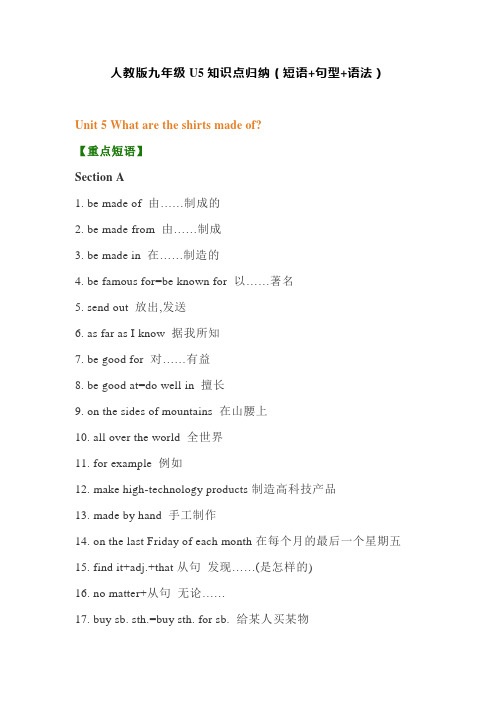
人教版九年级U5知识点归纳(短语+句型+语法)Unit 5 What are the shirts made of?【重点短语】Section A1. be made of 由……制成的2. be made from 由……制成3. be made in 在……制造的4. be famous for=be known for 以……著名5. send out 放出,发送6. as far as I know 据我所知7. be good for 对……有益8. be good at=do well in 擅长9. on the sides of mountains 在山腰上10. all over the world 全世界11. for example 例如12. make high-technology products制造高科技产品13. made by hand 手工制作14. on the last Friday of each month在每个月的最后一个星期五15. find it+adj.+that从句发现……(是怎样的)16. no matter+从句无论……17. buy sb. sth.=buy sth. for sb. 给某人买某物18. avoid doing sth. 避免做某事19. want to do sth. 想要做某事Section B1. the earth’s surface 地球表面2. traffic accident 交通事故3. a kite festival 风筝节4. turn…into… 把……变成……5. fly a kite =fly kites 放风筝6. be from=come from 来自7. many different kinds of 许多不同种类的8. such as 例如9. according to 根据;按照10. ask for help 请求帮助11. in trouble 处于困境中12. be covered with 用……覆盖13. rise into 上升;上涨14. a symbol of ……的象征15.during the Spring Festival 在春节期间16. paper cutting 剪纸17. good luck 好运18. put…on… 把……放在……上19. be used for doing sth. 被用于(做)……20. be used by 被……使用21. at a very high heat 在高温下22. sky lanterns 孔明灯23. fairy tale 童话故事24. go on a vacation to sp. 去某地度假25. “be+及物动词的过去分词”构成被动语态26. It seems that+从句好像……27. It takes sb. some time to do sth.做某事花费某人多长时间28. learn to do sth. 学会做某事29. allow sb. to do sth. 允许某人做某事30. be allowed to do 被允许做…31. try to do sth. 尽力做某事【重点句型】Section A1. What are the shirt made of?衬衫是由什么制成的?2. Is it made of silver?它是银质的吗?3. It was made in Thailand.它是在泰国制造的。
人教版 英语九年级 Unit5 重要知识归纳
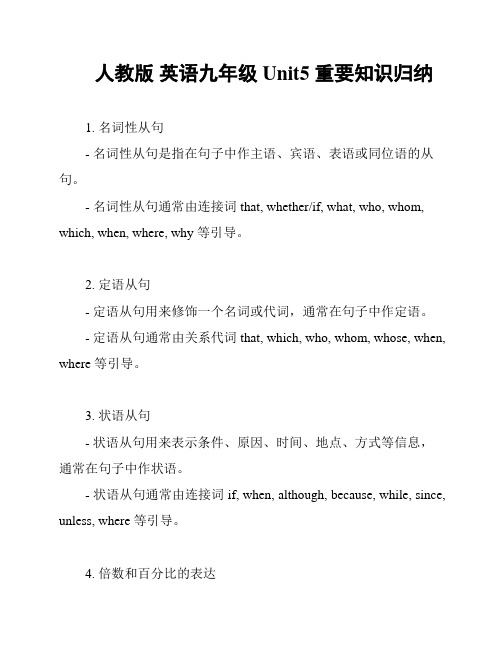
人教版英语九年级 Unit5 重要知识归纳
1. 名词性从句
- 名词性从句是指在句子中作主语、宾语、表语或同位语的从句。
- 名词性从句通常由连接词 that, whether/if, what, who, whom, which, when, where, why 等引导。
2. 定语从句
- 定语从句用来修饰一个名词或代词,通常在句子中作定语。
- 定语从句通常由关系代词 that, which, who, whom, whose, when, where 等引导。
3. 状语从句
- 状语从句用来表示条件、原因、时间、地点、方式等信息,
通常在句子中作状语。
- 状语从句通常由连接词 if, when, although, because, while, since, unless, where 等引导。
4. 倍数和百分比的表达
- 倍数表示方法:数字 + times
- 例如:two times, three times, etc.
- 百分比表示方法:数字 + 百分号
- 例如:10%, 25%, etc.
5. 句型转换
- 陈述句转换为疑问句:将句子的语序改为陈述疑问句语序。
- 一般疑问句转换为特殊疑问句:将疑问词放在句首,其余部分保持不变。
6. 词组和表达
- 一些常用的词组和表达:
- set up: 建立
- keep in touch: 保持联系
- on time: 准时
- look forward to: 期待
- take part in: 参加
以上是人教版英语九年级 Unit5 重要知识的归纳。
希望对你的学习有所帮助!。
人教版 英语九年级 Unit5 知识点整理

人教版英语九年级 Unit5 知识点整理1.本单元主要研究了以下几个知识点:宾语从句:宾语从句是一个完整的句子,作为主句的宾语。
它通常由连接词that。
whether。
if等引导。
例如:I ___ that he is a good student.动词不定式:动词不定式由to和动词原形构成,可以作为主语、宾语、表语和宾补等。
例如:To learn English well is my goal.形容词和副词比较级:形容词和副词的比较级用来表示两者之间的程度差异,形容词比较级通常在词尾加-er,也有不规则变化形式。
例如:This book is more interesting than the one I read before.特殊疑问词:特殊疑问词用来引导特殊疑问句,包括:what。
where。
when。
why。
who。
whom。
which。
how等。
例如:What is your favorite color?定语从句:定语从句是由关系代词或关系副词引导的从句,用来修饰一个名词或代词。
例如:The book that you lent me is very interesting.2.需要注意的几个语法点:不定式作主语时,动词不定式的逻辑主语是动词原形后面的动作的承受者。
例如:___.副词比较级的构成规则:形容词/副词比较级 + than + 原级 + [其他成分]。
例如:___.特殊疑问词的使用需要根据不同的情况进行选择。
例如:Where do you live?(询问地点)以上是本单元的知识点整理,希望对你的研究有所帮助。
Unit5笔记人教版英语九年级全册

Unit 5知识梳理总结【词汇梳理】coin(n.硬币)→Every coin has two sides. 凡事都有两面性。
glass(n.玻璃,不可数名词)→glasses(pl. 玻璃杯,可数名词)→a glass of milk一杯牛奶→a pair of glasses一副眼镜produce(v.生产;制造)→ product (n. 产品;制品)→ production (n. 生产)wide(adj.宽的)→ widely (adv. 广泛地;普遍地)→width(n.宽度;广度)France(法国)→ French (adj. 法国的;法国人的)boss(n.老板;上司)→ bosses (pl.)leaf(n.叶;叶子)→ leaves (pl.)grass(n.草地;草坪)→keep off the grass勿踏草坪Germany(n.德国)→ German (adj. 德国的;德语的;n. 德语;德国人)→ Germans (pl.)plete (v.完成)→pletely (adv.)form(n.形式;类型;使形成)→form a good habit养成好习惯fair(n.展览会;交易会)→(adj.公平的)→unfair( 反义adj.不公平的)【短语归纳】be made of... 由.....制成(能看出原材料)be made from... 由.....制成(看不出原材料)be made in... 在......制造be known /famous/wellknown for... 以......闻名be known /famous/wellknown as... 作为......而出名be known /famous/wellknown to... 为......所熟知as far as I know据我所知by hand手工avoid doing sth. 避免做某事no matter无论find out查明;弄清turn...into...将......变成......send out发送;发出be covered with覆盖着paper cutting剪纸【考点总结】1.be famous for,be famous as, be famous to①be famous for... 意为“因......而闻名”,后接原因,通常是名词。
人教版九年级英语unit5语法知识点

人教版九年级英语unit5语法知识点人教版九年级英语Unit 5 语法知识点在九年级的英语教材中,Unit 5 是一个比较重要的单元,我们将重点讨论一些与此单元相关的语法知识点。
这些知识点将帮助学生在学习英语时更加自信和地道。
1. 一般现在时 (Simple Present Tense)一般现在时用于表示经常性动作、习惯、规律或客观事实。
对于第三人称单数,动词需要加上's'。
例如:He walks to school every day.2. 现在进行时 (Present Continuous Tense)现在进行时用于表示正在进行的动作。
它由 "be" 动词的不同形式加上动词的现在分词形式构成。
例如:She is playing football now.3. 一般过去时 (Simple Past Tense)一般过去时用于表示过去某个特定的时间发生的动作或状态。
动词需要用过去式。
例如:I watched a movie last night.4. 过去进行时 (Past Continuous Tense)过去进行时表示过去某一时刻正在进行的动作或状态。
它由"was/were" 动词的不同形式加上动词的现在分词形式构成。
例如:They were studying when I called.5. 一般将来时 (Simple Future Tense)一般将来时用于表示将来某个时间将要发生的动作或状态。
通常使用 "will" 或 "be going to" 加上动词原形来构成。
例如:Wewill have a meeting next week.6. 现在完成时 (Present Perfect Tense)现在完成时用于表示过去某个时间开始并一直延续到现在的动作或状态。
它由"have/has" 加上动词的过去分词形式构成。
人教版九年级英语第五单元知识点梳理

人教版九年级英语第五单元知识点梳理Unit 5 What are the shirts made of?一、短语:1.everyday things日常用品2.be made in在……制造3.environmental protection环境保护4.be famous for以……而著名5.be produced in在……生产6.be known for以……闻名7.as far as I know据我所知8.pick by hand手工采摘9.send for发送10.avoid doing sth避免做某事二、知识点:1.made of:由……制(构)成,后接构成某物质的原料。
例:This skirt is made of silk.这件裙子是用丝绸制成的。
be made of/from/up of的区别:(1)be made of表示制成成品后,仍可看出原材料是什么。
保留原材料的质和形状,制作过程仅发生物理变化。
例:The kite is made of paper.风筝是用纸做的。
(2)be made from表示制成的东西完全失去了原材料的外形或特征,或原材料在制作过程中发生化学变化,在成品中已无法辨认。
例:The paper is made from wood.纸是木头做的。
Butter is made from milk.黄油是从牛奶中提炼出来的。
(3)be made up of表示用……构成或组成的,指人、物皆可,指结构成分。
例:Our class is made up of six groups.我们班是由六个小组组成的。
2.No matter what you may buy,you might think those products were made in those countries.无论你买什么,你都可能认为那些产品是在那些国家生产的。
此句为由no matter+特殊疑问词引导的让步状语从句。
人教版英语九年级Unit5单词+课文+知识梳理
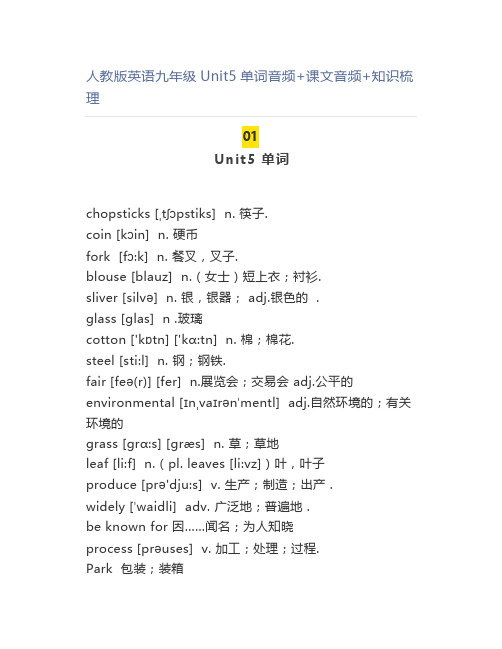
人教版英语九年级Unit5单词音频+课文音频+知识梳理01Unit5 单词chopsticks [ˌtʃɔpstiks] n. 筷子.coin [kɔin] n. 硬币fork [fɔ:k] n. 餐叉,叉子.blouse [blauz] n.(女士)短上衣;衬衫.sliver [silvə] n. 银,银器; adj.银色的 .glass [glas] n .玻璃cotton ['kɒtn] ['kɑ:tn] n. 棉;棉花.steel [sti:l] n. 钢;钢铁.fair [feə(r)] [fer] n.展览会;交易会 adj.公平的environmental [ɪnˌvaɪrənˈmentl] adj.自然环境的;有关环境的grass [ɡrɑ:s][ɡræs] n. 草;草地leaf [li:f] n.(pl. leaves [li:vz])叶,叶子produce [prə'dju:s] v. 生产;制造;出产 .widely [ˈwaidli] adv. 广泛地;普遍地 .be known for 因……闻名;为人知晓process [prəuses] v. 加工;处理;过程.Park 包装;装箱product [ˈprɒdʌkt][ˈprɑ:dʌkt] n. 产品;制品France [fra:ns], [fræns]法国 .no matter 不论;无论 .local [ˈləukl] adj. 当地的;本地的 .brand [brænd] n. 品牌;牌子avoid [əˈvɔid] v. 避免;回避 .handbag [ˈhændbæg] n. 小手提包mobile [ˈməubail] adj.可移动的;非固定的everyday ['evrideɪ] adj. 每天的;日常的boss [bɒs] [bɔ:s] n. 老板;上司Germany [ˈdʒə:(r)məni] n. 德国 .surface [sə:(r)fis] n. 表面;表层.material [məˈtiəriəl] n. 材料;原料 .traffic [ˈtræfɪk] n. 交通;路上行驶的车辆postman [ˈpəustmən] n. 邮递员 . cap [kæp] n(尤指有帽舌的)帽子glove [glʌv] n(分手指的)手套 .international [ˌintə(r) ˈnæʃnəl] adj. 国际的competitor [kəmˈpetitə(r)] n. 参赛者;竞争者its [its] adj. 它的form [fɔ:(r)m] n. 形式;类型clay [klei] n. 黏土;陶土celebration [ˌselɪˈbreɪʃn] n. 庆典;庆祝活动balloon [bəˈlu:n] n. 气球 .paper cutting 剪纸scissors [ˈsizə(r)z] n. (pl.) 剪刀lively [ˈlaivli] adj. 生气勃勃的;(色彩)鲜艳的fairy [ˈfeəri] [ˈferi] tale [teil] n 童话故事historical [hɪˈstɒrɪkl] adj.(有关)历史的heat [hi:t] n. 热;高温 v. 加热,变热polish [ˈpɒlɪʃ][ˈpɑ:lɪʃ] v. 磨光;修改;润色complete [kəmˈpli:t] v. 完成Korea [kəˈri:ə] 朝鲜;韩国Switzerland [switsə(r)lənd] 瑞士San Francisco [ˌsæn frənˈsiskəu] 圣弗朗西斯科(旧金山,美国城市)Marcus [ˈmɑ:kəs] n. 马库斯(男子名)Pam [pæm]帕姆(女名)02U n i t5课文03Unit5 知识梳理Unit 5 What are the shirts made of?【重点短语】1.be made of 由...制成的(表示制成成品后,仍可看出原材料是什么)2.be made from 由...制成的(在成品中已无法辨认原材料)3.be known for 以......闻名4.be used for 被用于......5.no matter 不论;无论6.be covered with 用...覆盖7.as far as I know 据我所知8.by hand 用手9.be good for 对……有益10.on the last friday of each month最后一个星期五11.be good at 擅长12.make high-technology products 制造高科技产品13.the earth’s surface 地球表面14.many different kinds of 许多不同种类的15.fly a kite 放风筝16.such as 例如17.according to 根据按照18.ask for help 请求帮助19.a symbol of ……的象征20.put…on… 把……放在……上21.be used for 被用于做……22.good luck 好运23.at a very high heat 在高温下24.be made in 在……制造的25.be famous for 以……著名26.on the sides of mountains 在山腰上27.traffic accident 交通事故28.a kite festival 风筝节29.be from 来自30.turn ……into ……把……变成……【重点句型】1. What are the shirts made of?衬衫是由什么制成的?2. It was made in Thailand.它是在泰国制造的。
人教版 英语九年级 Unit5 知识点总结
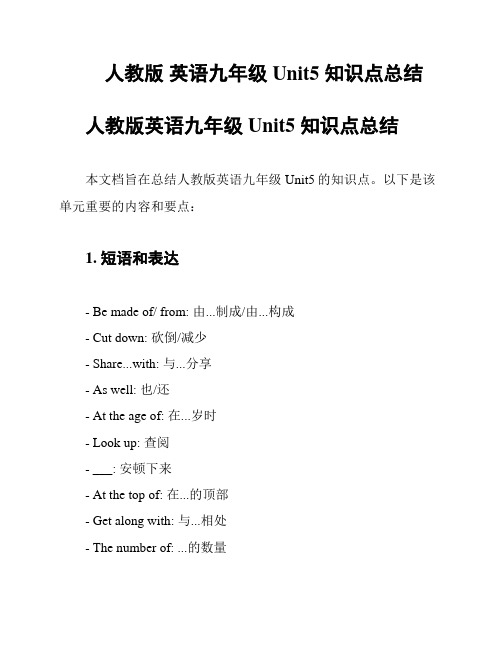
人教版英语九年级 Unit5 知识点总结人教版英语九年级 Unit5 知识点总结本文档旨在总结人教版英语九年级Unit5的知识点。
以下是该单元重要的内容和要点:1. 短语和表达- Be made of/ from: 由...制成/由...构成- Cut down: 砍倒/减少- Share...with: 与...分享- As well: 也/还- At the age of: 在...岁时- Look up: 查阅- ___: 安顿下来- At the top of: 在...的顶部- Get along with: 与...相处- The number of: ...的数量2. 句型和语法- 主语+ V-为-IO DO: 例如:___.(我给妈妈买了一件礼物。
)- There be句型: 例如:There is a big park near my house.(我家附近有一个大公园。
)- 状语从句: 例如:I will go swimming if it doesn't rain.(如果不下雨,我会去游泳。
)3. 词汇- Sweat: 汗水- Balanced: 均衡的- Environment: 环境- Admire: 钦佩- us: 好奇的- Basement: 地下室- Apartment: 公寓- Detector: 探测器- Forever: 永远- ___: 替换品请注意,以上内容仅为知识点总结,具体的例句、用法和解释请参考教材或额外的研究资料。
希望这份文档对您有所帮助!*文档字数:xxx字*。
人教版 英语九年级 Unit5 知识点整理
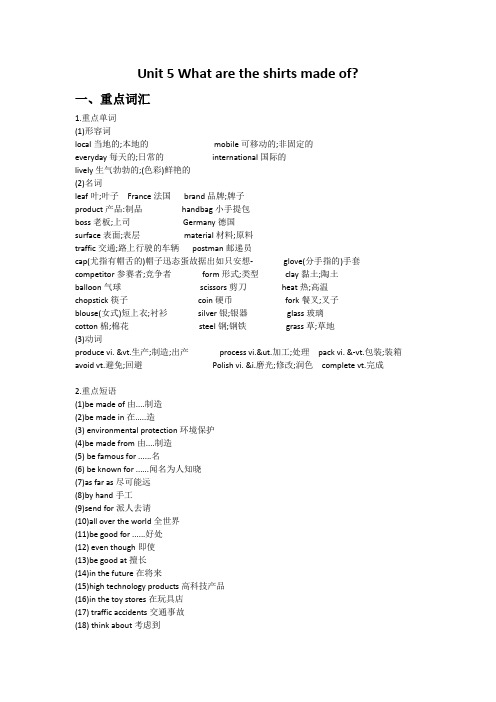
Unit 5 What are the shirts made of?一、重点词汇1.重点单词(1)形容词local当地的;本地的mobile可移动的;非固定的everyday每天的;日常的international国际的lively生气勃勃的;(色彩)鲜艳的(2)名词leaf叶;叶子France法国brand品牌;牌子product产品:制品handbag小手提包boss老板;上司Germany德国surface表面;表层material材料;原料traffic交通;路上行驶的车辆postman邮递员cap(尤指有帽舌的)帽子迅态蛋故据出如只安想- glove(分手指的)手套competitor参赛者;竞争者form形式;类型clay黏土;陶土balloon气球scissors剪刀heat热;高温chopstick筷子coin硬币fork餐叉;叉子blouse(女式)短上衣;衬衫silver银;银器glass玻璃cotton棉;棉花steel钢;钢铁grass草;草地(3)动词produce vi. &vt.生产;制造;出产process vi.&ut.加工;处理pack vi. &-vt.包装;装箱avoid vt.避免;回避Polish vi. &i.磨光;修改;润色complete vt.完成2.重点短语(1)be made of由....制造(2)be made in在.....造(3) environmental protection环境保护(4)be made from由....制造(5) be famous for ......名(6) be known for ......闻名为人知晓(7)as far as尽可能远(8)by hand手工(9)send for派人去请(10)all over the world全世界(11)be good for ......好处(12) even though即使(13)be good at擅长(14)in the future在将来(15)high technology products高科技产品(16)in the toy stores在玩具店(17) traffic accidents交通事故(18) think about考虑到(19)make a kite制作一个风筝(20)fly a kite放风筝(21)turn... into. ..把....变...(22)ask for help请求帮助(23)in trouble处于困境中(24)be covered with被...覆盖(25)rise into升到(26)fairy tale童话故事(27)no matter不论;无论(28) paper cutting剪纸(29) symbols of wishes祝愿的象征二、重要句型1. Is it made of silver?它是由银子制作的吗?(1)be made+介词短语Be made of是.....制成的。
人教版英语九年级 Unit5 重点知识归纳

Unit 5 知识清单Section A重点短语1.be made of 由…制成(看得见原材料)2.be made from由…制成(看不见原材料)2.environmental protection环境保护3.pay to do sth. 花钱做某事4.be widely known for 广为人知5.as far as I know 就我所知6. be picked by hand 手工挑选/采摘7. in many different areas在不同地区8. search for 寻找9. no matter 无论10. even though 即使11.be covered by 被….覆盖12. avoid doing sth. 避免做…. 13.high-technology products 高科技产品14 .the earth’s surface 地球表面15.cause traffic accidents 导致交通事故16.a pair of chopsticks 一双筷子17. a pair of gloves 一副手套18. A hundred percent cotton 纯棉19. attend for free 免费参加重点语法:被动语态一.基本结构:be + 动词过去分词肯定句:主语+be + 过去分词+(by ~)否定句:主语+be not +过去分词一般疑问句:Be +主语+过去分词+(by ~)? 特殊疑问句:疑问词+be+主语+过去分词+(by ~)?需注意:进行否定句或疑问句句型转换时,如有助动词(have/has/had/will/would+been/be+过分),则在助动词上变;其余情况都直接在am/is/are/was/were上变化。
二.具体时态如下:一般现在时的被动语态:主+am / is / are (not)+过去分词一般过去时的被动语态:主+was / were +过去分词现在进行时被动语态:主语+is / am / are + being +过去分词现在完成时被动语态:主语+have / has +been +过去分词一般将来时:主语+will +be +过去分词过去将来时:主语+would + be +过去分词过去进行时:主语+was / were + being +过去分词过去完成时:主语+had + been +过去分词现在完成进行时态:主语+have/has +been+being+过去分词含有情态动词的被动语态:情态动词+be+过去分词三.什么时候不用被动语态?(1)look,sound,smell,taste等系动词,用主动形式表示被动含义。
人教版九年级全一册英语Unit5单元语法知识点总结

人教版九年级全一册英语Unit5单元语法知识点总结本单元重点短语的具体用法1. be made of:表示某物由某种材料制成,且制成后原材料仍可辨认。
例如:- This table is made of wood. 这张桌子是由木头制成的。
2. be made from:与“be made of”意思相近,但强调制成的物品已经看不出原材料。
例如:- Paper is made from wood. 纸是由木头制成的。
3. be known for:意为“因……而闻名”。
例如:- This city is known for its beautiful beaches. 这座城市以其美丽的海滩而闻名。
4. be used for:表示某物被用于某种目的。
例如:- This tool is used for cutting wood. 这个工具是用来砍木头的。
5. no matter:“不论;无论”,引导让步状语从句。
例如:- No matter what happens, I will always support you. 无论发生什么,我都会一直支持你。
6. be covered with:表示被某种东西覆盖。
例如:- The ground is covered with snow. 地面被雪覆盖了。
7. as far as I know:“据我所知”,常用在句首。
例如:- As far as I know, she is a very kind person. 据我所知,她是一个非常善良的人。
8. by hand:“用手”,强调手工制作。
例如:- These cookies were made by hand. 这些饼干是手工制作的。
9. be good for:“对……有益”,例如:- Exercising is good for your health. 锻炼对你的健康有好处。
10. on the last Friday of each month:“在每个月的最后一个星期五”,例如:- The meeting is always held on the last Friday of each month. 会议总是在每个月的最后一个星期五举行。
人教版九年级英语全册Unit5知识点
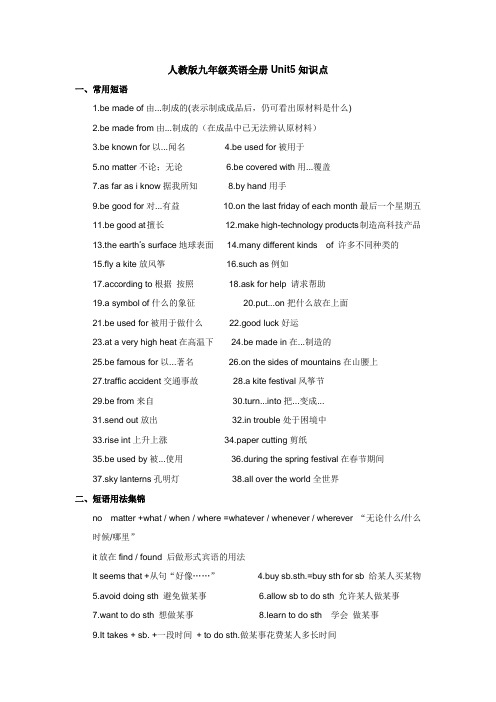
人教版九年级英语全册Unit5知识点一、常用短语1.be made of由...制成的(表示制成成品后,仍可看出原材料是什么)2.be made from由...制成的(在成品中已无法辨认原材料)3.be known for以...闻名4.be used for被用于5.no matter不论;无论6.be covered with用...覆盖7.as far as i know据我所知8.by hand用手9.be good for对...有益10.on the last friday of each month最后一个星期五11.be good at擅长12.make high-technology products制造高科技产品13.the earth’s surface地球表面14.many different kinds of 许多不同种类的15.fly a kite放风筝16.such as例如17.according to根据按照18.ask for help 请求帮助19.a symbol of什么的象征20.put...on把什么放在上面21.be used for被用于做什么22.good luck好运23.at a very high heat在高温下24.be made in在...制造的25.be famous for以...著名26.on the sides of mountains在山腰上27.traffic accident交通事故28.a kite festival风筝节29.be from来自30.turn...into把...变成...31.send out放出32.in trouble处于困境中33.rise int上升上涨34.paper cutting剪纸35.be used by被...使用36.during the spring festival在春节期间37.sky lanterns孔明灯38.all over the world全世界二、短语用法集锦no matter +what / when / where =whatever / whenever / wherever “无论什么/什么时候/哪里”it放在find / found 后做形式宾语的用法It seems that +从句“好像……” 4.buy sb.sth.=buy sth for sb 给某人买某物5.avoid doing sth 避免做某事6.allow sb to do sth 允许某人做某事7.want to do sth 想做某事8.learn to do sth 学会做某事9.It takes + sb. +一段时间+ to do sth.做某事花费某人多长时间10.try to do sth 尽力做某事10.辨析:be made of 由...制作/制造(材料):在成品中能看出原材料be made from由...制造/制成(材料):在成品中看不出原材料be made in在...制作/制造 (产地) Made in China.中国制造例:The desk is made of wood. Bread is made of flour.The paper is made from wood. Wine is made of grapes.This kind of plane is made in China.11. be famous for 以...闻名;为人知晓be known for因...而闻名be famous as作为...而闻名be known as作为...而闻名例:Jingdezhen is famous for china.China is famous for its tourism.Mo Yan is very famous as a writer.12. allow sb to do sth允许某人做某事allow doing sthbe allowed to do sth例:Please allow me to come in.My boss doesn't allow me to use the telephone.We were not allowed to talk in class.They allowed smoking in this room only.注意:allow只可搭配动名词短语作宾语,不可直接搭用动词不定式作宾补,即只可说allow doing sth,不可说allow to do sth.13.一般现在时的被动语态(见P155页)结构:am/is/are+过去分词。
人教版英语九年级全一册第五单元知识点整理

九Unit5 What are the shirts made of?P331. Do you think this ring looks good?---Hmm…yes, I think it’s quite pretty. Is it made of silver?---Yes, and it was made in Thailand. quite 相当副词修饰形容词辨析:1. be made of 用……制造(指原材料没有发生化学上的变化)/ (a material) 表示用某种材料制成,物理变化。
eg. The teapot is made of silver.2.be made from 用……制造(指原材料发生化学上的变化,看不出原材料)/ 表示数种材料制成。
eg. Glass is made from sand and lime(石灰).3.be made by+人由谁制造的eg. This shelf was made by my grandpa.4.be made in +产地在……制造eg. The violin was made in Germany.5.be made up of 由……组成,由……构成eg. This club is made up of more than more than 200 members。
被动语态:主动语态强调人,被动语态强调事。
结构:be done be动词用来体现时态,done过去分词,用来体现被动一现:am/is/are done 一过was/were done 一将:will be done 现进:am/is/are being done 现完:have/has been done 含有情态动词:must be done 动词不定式:to be done v-ing 被动:being doneP34 1. China is famous for tea, right?A. be famous for……因……而闻名=be known for 以……闻名B. be famous as 作为……而出名;作为……而闻名The area is famous as a green tea producing place.C. be famous to 为……所熟知eg. They may not be famous to the general public.2.How is tea produced? Well, as far as I know, tea plants are grown on the sides of mountains. When the leaves are ready, they are picked by hand and then are sent for processing. be done 被动结构3.People say that tea is good for both health and business.连词:both…and………和……两个都a. 构成短语做主语是,谓语复数b. 否定句是部分否定He can't play both the violin and the piano.c. 所连接的前后两部分的成分必须一致其他并列连词:You are right. I am right.Either you or I am right.(就近原则)He plays soccer. He plays basketball.He plays either soccer or basketball.①either…or…或……或……不是……就是……a. 由either…or…构成的短语做主语时,谓语动词随其临近的词,即or后的词而定(就近原则)b. or 前后词性必须一致I don't like beef. I don't like lamb, either.I like neither beef nor lamb.He isn't right. I am not right.Neither he nor I am right.or Neither I nor he is right.②neither… nor… 既不……也不a. 由neither…nor…构成的短语作主语时,谓语动词随其临近的词,即nor后的词(近后原则)b. neither …nor… 本身是全否定,故不再用否定,即不再加notc. nor 前后的词性必须一致You must wash the dishes. You must sweep the floor.You must not only wash the dishes but sweep the floor as well.③not only…but also…not only…but … as well 不但…而且…a.连接对等的词或词组b. 连接的短语作主语时,谓语动词随but also/but 后面的词而定(就近原则)be good for 对……有益eg. Herb tea is good for your health.be good with 善于应付……的eg. She is good with kids.be good to 对……友好eg. My grandmother is good to me.be good at =do well in 擅长eg. I am good at learning new knowledge.P35 1. He found it interesting that so many products in the local shops were madein China. it 形式宾语,that从句真正的宾语2.But I had to visit five or six stores before finding a pair made in America! had to 表示过去不得不before+动名词这个结构相当于一个时间状语从句,表示动作的先后顺序可以用after, before; on+动名词通常表示两个动作几乎同时发生。
人教版英语九年级u5知识点

人教版英语九年级u5知识点九年级英语 Unit 5 知识点解析一、词汇篇在九年级英语 Unit 5 中,有一些重要的词汇需要我们掌握。
首先是关于人物的词汇。
比如,我们需要了解并掌握“父母亲”(parents)、“祖父母”(grandparents)、“叔叔”(uncle)、“阿姨”(aunt)、“表兄弟姐妹”(cousin)等词汇。
其次是关于身体部位的词汇。
比如,我们需要了解并掌握“头”(head)、“手”(hand)、“脚”(foot)、“眼睛”(eye)、“口”(mouth)等词汇。
再次是关于食物和饮品的词汇。
比如,我们需要了解并掌握“面包”(bread)、“牛奶”(milk)、“咖啡”(coffee)、“水果”(fruit)等词汇。
最后是关于活动和娱乐的词汇。
比如,我们需要了解并掌握“阅读”(reading)、“游泳”(swimming)、“旅行”(travel)、“音乐”(music)等词汇。
二、语法篇九年级英语 Unit 5 中,也有一些重要的语法点需要我们掌握。
首先是一般现在时的用法。
我们需要了解并掌握一般现在时表示的动作或状态的规律性和经常性。
其次是情态动词 can 的用法。
我们需要了解并掌握 can 表示的能力、许可和请求等意义。
再次是现在进行时的用法。
我们需要了解并掌握现在进行时表示的正在进行的动作、临时性的状态或固定安排等含义。
最后是一些基本的句型。
比如,我们需要了解并掌握肯定句、否定句、一般疑问句、特殊疑问句等的构成和用法。
三、阅读篇在九年级英语 Unit 5 中,有一篇阅读理解需要我们仔细阅读并掌握其中的信息。
这篇阅读理解主要介绍了一个学生的生活。
文中提到了他的家庭成员、兴趣爱好以及他平时是如何度过他的一天的。
通过阅读,我们可以了解到他的生活非常丰富多样,每天都很充实。
阅读理解是提高英语阅读理解能力的重要途径,通过阅读可以帮助我们提高对文章的理解能力以及提高我们的阅读速度。
人教版九年级英语unit5知识点
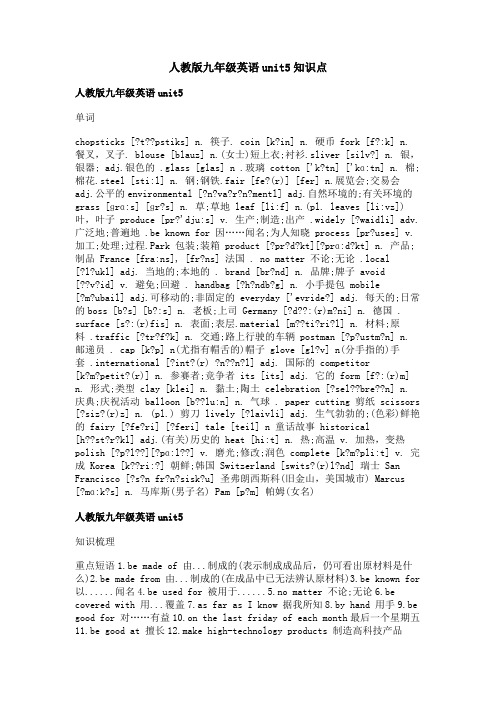
人教版九年级英语unit5知识点人教版九年级英语unit5单词chopsticks [?t??pstiks] n. 筷子. coin [k?in] n. 硬币 fork [f?:k] n. 餐叉,叉子. blouse [blauz] n.(女士)短上衣;衬衫.sliver [silv?] n. 银,银器; adj.银色的 .glass [glas] n .玻璃 cotton ['k?tn] ['kɑ:tn] n. 棉;棉花.steel [sti:l] n. 钢;钢铁.fair [fe?(r)] [fer] n.展览会;交易会adj.公平的environmental [?n?va?r?n?mentl] adj.自然环境的;有关环境的grass [ɡrɑ:s] [ɡr?s] n. 草;草地 leaf [li:f] n.(pl. leaves [li:vz])叶,叶子 produce [pr?'dju:s] v. 生产;制造;出产 .widely [?waidli] adv. 广泛地;普遍地 .be known for 因……闻名;为人知晓 process [pr?uses] v. 加工;处理;过程.Park 包装;装箱 product [?pr?d?kt][?prɑ:d?kt] n. 产品;制品 France [fra:ns], [fr?ns] 法国 . no matter 不论;无论 .local[?l?ukl] adj. 当地的;本地的 . brand [br?nd] n. 品牌;牌子 avoid[??v?id] v. 避免;回避 . handbag [?h?ndb?g] n. 小手提包 mobile[?m?ubail] adj.可移动的;非固定的 everyday ['evride?] adj. 每天的;日常的boss [b?s] [b?:s] n. 老板;上司 Germany [?d??:(r)m?ni] n. 德国 . surface [s?:(r)fis] n. 表面;表层.material [m??ti?ri?l] n. 材料;原料 .traffic [?tr?f?k] n. 交通;路上行驶的车辆 postman [?p?ustm?n] n. 邮递员 . cap [k?p] n(尤指有帽舌的)帽子 glove [gl?v] n(分手指的)手套 .international [?int?(r) ?n??n?l] adj. 国际的 competitor[k?m?petit?(r)] n. 参赛者;竞争者 its [its] adj. 它的 form [f?:(r)m] n. 形式;类型 clay [klei] n. 黏土;陶土 celebration [?sel??bre??n] n. 庆典;庆祝活动 balloon [b??lu:n] n. 气球 . paper cutting 剪纸 scissors [?siz?(r)z] n. (pl.) 剪刀 lively [?laivli] adj. 生气勃勃的;(色彩)鲜艳的 fairy [?fe?ri] [?feri] tale [teil] n 童话故事 historical[h??st?r?kl] adj.(有关)历史的 heat [hi:t] n. 热;高温 v. 加热,变热polish [?p?l??][?pɑ:l??] v. 磨光;修改;润色 complete [k?m?pli:t] v. 完成 Korea [k??ri:?] 朝鲜;韩国 Switzerland [swits?(r)l?nd] 瑞士 San Francisco [?s?n fr?n?sisk?u] 圣弗朗西斯科(旧金山,美国城市) Marcus [?mɑ:k?s] n. 马库斯(男子名) Pam [p?m] 帕姆(女名)人教版九年级英语unit5知识梳理重点短语1.be made of 由...制成的(表示制成成品后,仍可看出原材料是什么)2.be made from 由...制成的(在成品中已无法辨认原材料)3.be known for 以......闻名4.be used for 被用于......5.no matter 不论;无论6.be covered with 用...覆盖7.as far as I know 据我所知8.by hand 用手9.be good for 对……有益10.on the last friday of each month最后一个星期五11.be good at 擅长12.make high-technology products 制造高科技产品13.the earth’s surfac e 地球表面14.many different kinds of 许多不同种类的15.fly a kite 放风筝16.such as 例如17.according to 根据按照18.ask for help 请求帮助19.a symbol of ……的象征20.put…on… 把……放在……上21.be used for 被用于做……22.good luck 好运23.at a very high heat 在高温下24.be made in 在……制造的25.be famous for 以……著名26.on the sides of mountains 在山腰上27.traffic accident 交通事故28.a kite festival 风筝节29.be from 来自30.turn ……into ……把……变成……重点句型1. What are the shirts made of?衬衫是由什么制成的?2. It was made in Thailand.它是在泰国制造的。
人教版九年级英语Unit 5知识点整理

Unit 5短语知识点整理1.be made of由...制成(能看出原材料)be made from 由...制成(看不出原材料)be made in 在...制成be made into (原材料)被制成…2. environmental protection 环境保护protect environment 保护环境3.be famous for 因...而著名4.be famous as 作为...而著名4. be known for 因...而著名be known as 作为...而著名5. as far as I know据我所知6. be produced 被制作/produce v. 生产;制造;product n. 产品/production n. 生产7. be grown 被种植8. by hand 手工9. be picked 被采摘10.be sent for processing 被送去加工11. be packed 被包装12. all over the world =around the world全世界13.be good for 对...有好处be good at (doing) sth 擅长于(做)某事14. no matter what 无论什么no matter when 无论何时no matter where 无论何处no matter how 无论如何15. find it adj. to do sth. find it adj. that +句子发现做某事/ 某件事...16.buy sth. for sb.= buy sb. sth.为某人买某物17.a pair of basketball shoes一双篮球鞋18.avoid doing sth. 避免做某事19. in fact 事实上20. everyday things 日常用品21.in the future 在将来22.make high-technology products制作高科技产品23. shopping experiences购物经历24. be paid 被支付25. allow sb. to do sth. 允许某人做某事be allowed to do sth. 被允许做某事26. be spoken 被说27. careless driving 粗心的驾驶28. traffic accidents 交通事故29. an international kite festival 国际风筝节30. learn to do sth. 学习做某事31. be held 被举行32. many different kinds of 许多不同种类的...33. special forms of traditional art独特的传统艺术形式34. according to... 根据...35. turn...into... 把...变成be turned into ...被变成36. send...out 发送;派送37. (be) in trouble (处于)麻烦38. cover... with ... 用...覆盖be covered with 被覆盖39. rise into the air 升入空中( rise --rose--risen )40. be seen as 被看作(see-- saw--seen)41. symbols of happiness and good wishes幸福和美好祝愿的象征42. be folded 被折叠43. be cut 被剪切44. during Spring Festival 春节期间45. paper cutting 剪纸46. fairy tale 童话故事47. historical story 历史故事48. at a very high heat 在高温下49. be used for doing sth. = be used to do sth.被用来做...50. on the sides of mountains 在山坡上51. It takes sb. some time to do sth.花费某人多长时间干某事sb. spend time/money (in) doing sth.某人花费时间/金钱做某事sth. cost sb. money 某物花费某人多钱sb. pay for sth.某人花费多少钱为某物52. tea plants茶树53. in France 在法国54. in the local shops 在当地的商店55. American brands美国品牌56. even though 即使57. mobile phone移动电话58. in Germany 在德国59.the earth’s surface地球表面60.Chinese clay art 中国的陶瓷艺术61. sky lanterns 孔明灯62. put…on … 把……放到…..上63. lively characters 生动的角色64. be shaped被塑形64. be fired被烧制65. be polished 被打磨三、词法和句法1. Have / has been around 这是习语,意思是“已经存在”Poetry has been around for centuries . 诗歌已经存在几个世纪了。
Unit+5单元知识点梳理2023-2024学年人教版英语九年级全册

Grammar 被动语态(1)主动关系(主语为动作执行者):主动语态(The active voice)(2)被动关系(主语为动作承受者):被动语态(The passive voice)II.结构:主动句—— A do B He eats an apple every day.被动句——B be done (by A) An apple is eaten by him every day.III.主动变被动方法: 1. 把句子中的宾语变为被动句的主语2. 把主动句中的谓语变成被动句的be done形式,注意时态保持一致3. 把主句中的主语变成by的宾语,如果不强调动作执行者by sb.可省略e.g. He often ask me questions. I am often asked questions by him.She sang mang songs last night. →Mang songs were sung by her.Who broke the window? Who/ Whom was the window broken by?= By whom was the window broken?Such books are written for children.English is spoken as an international language around the world.My computer was stolen last night.IV.各个时态的被动语态时态一般时态进行时态完成时态现在amis →doneare amis →being donearehas→been donehave过去was→donewere was→being donewerehad been done将来shallwill →be donebe going to过去将来shouldwould →be donewas/were going toOur classroon ______ ______ (clean) every day.I _____ ______ ( ask) to study hard by my mother.Knives ______ ______ (use) for cuttig things.2. 一般过去时的被动语态A new shop ______ ______ (build) last year.Those Dinosuar eggs ______ ______ (lay) long time ago.3. 一般过去时的被动语态A new hospital ______ ______ ______( build) in our city.Many more trees are going to ______ ______ (plant) next year.4. 现在进行时的被动语态Uncle Wang is mending my bike now. →__________________________________________________.They are planting trees over there. →__________________________________________________.5. 现在完成时的被动语态This book ________ ________ ________ (translate) into many languages.Many man-made satellites ________ ________ ________ (send) up into space by many countries.*6. 过去进行时的被动语态A kite ________ ________ ________(make) by my brother when I came into his room.*7. 过去完成式的被动语态Many school ________ ________ ________ (build) by the end of last year.*8. 过去将来时的被动语态He said his homework ________ ________ _______ (finish) soon.V. 情态动词的被动形式can/may +be done, could/might +be done, needn’t/should/must +be donee.g. Young trees must ________ ________ (water) often.Your mistakes should ________ ________ (correct) right now.The doctor may ________ ________ (lock) inside.Your hometown can ________ ________ (hand) in tomorrow.VI. 注意事项1. 含有双宾语的动词在间接宾语前用介词to的:bring/take/lend/pass/sell/show/teach/tell在间接宾语前用介词for的:buy/cook/get/make/sing/fetche. g. He gave me a present yesterday. ○1I was given a present by him yesterday.○2 A present was given to me by him yesterday. Exercises:I lent her me bike last week.○1○2My mom made me a new sweater.○1○2He writes her a letter every two weeks.○1○2The old man told us a story yesterday.○1○2My best friend brought me a book this morning.○1○2My best friend bought me a book this morning.○1○22. 不及物动词作谓语的句子变被动语态时,介词或副词不能省。
- 1、下载文档前请自行甄别文档内容的完整性,平台不提供额外的编辑、内容补充、找答案等附加服务。
- 2、"仅部分预览"的文档,不可在线预览部分如存在完整性等问题,可反馈申请退款(可完整预览的文档不适用该条件!)。
- 3、如文档侵犯您的权益,请联系客服反馈,我们会尽快为您处理(人工客服工作时间:9:00-18:30)。
Unit5 What are the shirts made of?
【重点短语】
1. be made of 由……制造
2. be made in 在……制造
3. environmental protection 环境保护
4. be famous for 以……而著名
5. be produced in 在……生产
6. be known for 以……闻名
7. as far as I know 据我所知
8. pick by hand 手工采摘
9. send for 发送
10. avoid doing sth 避免做某事
11. everyday things 日用品
【考点详解】
1. made of 由……制(构)成,后接构成某物质的原料。
例:This skirt is made of silk.这件裙子是用丝绸制成的。
be made of/from/up of的区别
(1)be made of 表示制成成品后,仍可看出原材料是什么,保留原材料的质和形状,制作过程仅发生物理变化。
例:The kite is made of paper.风筝是用纸做的。
(2)be made from 表示制成的东西完全失去了原材料的外形或特征,或原材料在制作过程中发生化学变化,在成品中已无法辨认。
例:The paper is made from wood.纸是木头做的。
Butter is made from milk. 黄油是从牛奶中提炼出来的。
(3)be made up of 用……构成或组成的,指人、物皆可,指结构成分。
例:Our class is made up of six groups. 我们班是由六个小组组成的。
2. It seems that many people all over the world drink Chinese tea.
好像全世界的许多人都在喝中国茶。
句型“It seems that…”意为“看起来好像/似乎……”,其中seem是连系动词,意为“似乎;好像”,句型中的it是形式主语,不能用其他代词来替代。
例:It seems that he was late for the train. 看来他没赶上火车。
seem的几种常见结构:
(1)seem to do sth此句型可与“It seems that…”转换。
例:They seem to find the way to the cinema. =It seems that they find the way to the cinema.
他们似乎找到了去电影院的路了。
(2)seem+形容词
例:My temperature seems (to be) all right. 我的体温看上去正常了。
(3)seem+名词
例:That seems not a bad idea. 看上去主意不错。
3. When the leaves are ready, they are picked by hand and then are sent for processing in factory.
当茶叶成熟时,就被用手工采摘然后送到工厂加工。
此句是由when 引导的时间状语从句,are picked, are sent都是一般现在时的被动结构。
例:When the fruit are ready, they are picked and are sent to the market for sale.
当这些水果成熟后就被摘下来并送到市场上卖掉。
4. No matter what you may buy, you might think those products were made in those countries.
无论你买什么,你都可能认为那些产品是在那些国家生产的。
此句为由"no matter +特殊疑问词"引导让步状语从句。
意为“无论….”,相当于whatever。
例:No matter what I said to her, she still didn’t believe me.
无论我对她说什么,她仍然不相信我。
5. find out, 查出,找到。
例:The police are trying to find out where the boy got off the train.
警察正在查找这个男孩是从哪下的火车。
find,find out和look for都含有“寻找、找到”的意思,但其含义和用法却不同。
①find意为“找到、发现”,通常指找到或发现具体的东西,强调的是找的结果。
Will you find mea pen? 你替我找支钢笔好吗?
②look for意为“寻找”,是有目的地找,强调“寻找”这一动作。
例:I’m looking for my pen everywhere. 我正到处找我的钢笔。
He is looking for his shoes. 他在找他的鞋子。
③find out意为“找出、发现、查明”,多指通过调查、寻问、打听、研究之后“搞清楚、弄明白”,通常含有“经过困难曲折”的含义,指找出较难找到的、无形的、抽象的东西。
例:Please find out when the train leaves. 请查一下火车什么时候离站。
Read this passage,and find out the answer to this question.
【重点语法】
一般现在时的被动语态
一. 概念理解
1. 时态:在英语语言中,时态主要讨论行为动词发生的时间。
如:He often helps me with my English. 他经常帮助我学英语。
(help这个动作经常发生often;故用一般现在时)
2. 语态:在英语语言中,语态主要讨论句子主语与行为动词的关系。
语态有两种:主动语态和被动语态。
①主语是动作的发出者(执行者)为主动语态。
如:The tall boy often hits his classmates (主语boy是谓语动词hit的发出者)。
②主语是动作的接受者(承受者)为被动语态。
汉语中常用“被”、“给”、“由”、“受”等词用来表示被动,而英语用:助动词be + 及物动词的过去分词构成
如:Chinese is spoken by the most people in the world(主语Chinese是谓语动词speak的承受者)。
3. 语态与时态的关系:在任何一个英语句子中都同时存在语态和时态,他们是分析一个英语句子的两个主要元素。
如:①He is looking after his sister at home. (此句为现在进行时的主动语态结构)
②He is being looked after well by his parents. (此句为现在进行时的被动语态结构)
二. 被动语态最基本的句型结构:be +及物动词过去分词
说明:①be 有时态,人称和数的变化。
②被动语态中的谓语动词必须是及物动词;因为被动句中的主语是动作的承受者,某些短语动词如look after, think of, take care of, work out, laugh at等,也可用于被动语态。
三. 被动语态的使用
1. 当不知道或没有必要指出动作的执行者时,常用被动语态,这时往往不用by 短语。
Mr. White, the cup with mixture was broken after class. (只是告诉老师杯子坏了,不知是谁弄坏的,或不想说出谁弄坏的)。
2. 突出或强调动作的承受者,如果需要说出动作的执行者,用by 短语。
如:The cup was broken by Paul.
四. 主动语态变被动语态的变法:主动语态与被动语态之间如何转换
1. 把主动语态的宾语变成被动语态的主语。
2. 把主动语态的谓语变成被动语态的be + 过去分词,时态要与原句保持一致。
3. 把主动语态的主语变为介词by的宾语,放在被动语态里谓语动词之后,by 短语可以省略。
如果原句主语是地点名词,在被动语态中用in + 地点名词作状语。
五. 一般现在时的被动语态:am /is/ are +done
如:Tea is grown in Hangzhou. 杭州种植茶叶。
